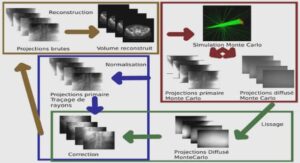Phase diffusion
Even though two completely separate condensates can have a fixed relative phase if coherently split, this “phase memory” gets lost (and reappears in a revival) on a specific timescale tD due to the fundamental process of phase diffusion: In a technically perfect experiment, the number of atoms in each well fluctuates due to the uncertainty principle [40]. Assuming Poissonian noise, these fluctuations are on the order of p N, where N is the total number of atoms. As interactions contribute to the total energy in each cloud, fluctuations in atom number lead to corresponding fluctuations in the evolution of the differential phase, washing out the phase in repeated realizations of the experiment [41,42]. The exact timescale of this process is an ongoing issue of discussion, for Poissonian number fluctuations in a completely decoupled 3D double well we find [41, 43]: TD ‘ 5h p N 2μ (1.69) where μ is the BEC chemical potential. As discussed in [44], fluctuations in atom number become sub-Poissonian for strongly interacting clouds; a non-negligible tunnel coupling between the wave packets leads to complex phase dynamics, possibly counteracting the phase diffusion [45]. The role of dimensionality of the system has not been considered so far. All authors agree, that the timescale for phase diffusion is approximately two orders of magnitude above the oscillation period in a single well. Experimental observation of phase diffusion in Bose-Einstein condensates is therefore a major technological challenge, as not only the splitting has to be performed in a coherent fashion, but the coherence has to be “kept alive” for a long time, unaffected by technical fluctuations and noise. Due to high trap frequencies, chip-based magnetic double wells as presented in this manuscript are well suited to address this problem. Here, phase diffusion times may be reduced to a few tens of milliseconds, which may be within the reach of current experiments.
Double well physics This chapter resumes the theory of Bose-Einstein condensates in double well potentials. The strong (nonlinear) influence of interactions enriches the bosonic system compared to e.g. superconducting tunnel junctions. The macroscopic condensate wave function allows for direct observation of tunnel currents, the phase information is easily accessible through interference experiments. This topic has therefore attracted an enormous amount of attention in the recent literature, which is vast and partly controversial. The chapter is divided into two sections, aiming to develop some theoretical background to the experimental implementations of double wells, described in part 2 and 3 of the manuscript. Section 2.1 describes the static double well. A mean field two modes model is used to derive dynamics of the non-interacting and the interacting Bose gas for different regimes. Where it is relevant for the design and understanding of the experimental implementation, we go beyond the two modes model and briefly discuss instabilities and phase fluctuations due to nonlinear coupling to (additional) energetically low lying modes.
Parameter constrains found in this analysis are closely related to the actual realization of a double well potential based on nano-fabricated wires presented in part 2. Section 2.2 describes the Bose condensate in a dynamic double well and tries to understand the splitting process, as it will be experimentally demonstrated in part 3. Here, a quantum phase model is implied to describe the internal dynamics throughout the splitting process and the unavoidable breakdown of adiabaticity due to the (exponentially) vanishing tunnel coupling. 2.1 The static double well We will first concentrate on the non-interacting Bose gas in a symmetric double well, as schematically illustrated in figure (2.1). For a very high potential barrier, the two wells are completely isolated, their equally spaced (single particle) eigenstates of energy ~_ are these of an harmonic oscillator of trap frequency !0: ~_ = ~!0 [46]. For a low potential barrier, the two lowest lying (symmetric and antisymmetric) states of the system are delocalized over both wells, their energy difference ~_ describes the tunnel coupling. We will restrict our analysis to the situation, where _ _ _ and only the symmetric and the antisymmetric state are necessary to characterize the system. This two modes model has been widely discussed in the literature, as it allows for analytic expressions of the system dynamics [47, 44, 48, 49, 50, 51].
In general it is fairly realistic when the symmetric and the antisymmetric state are well separated from higher modes, it has limited validity in the case of a a very low potential barrier (when it is not allowed to neglect higher excitation modes) and in the case of strong atom-atom interactions. We introduce a Figure 2.1: Schematic representation of the double well level structure: levels below the potential barrier are (almost) twofold degenerate, their energy difference characterizes the tunnel coupling. To avoid excitations due to tunnelling dynamics, it is favorable to design the double well such as ~_ ‘ 10~_ (two modes tunnelling). generic double well potential Vtrap(r) = m!0 8r2 0 r2 − r2 0 _2 (2.1) where ±r0 denotes the positions of the potential minima, !0 is the single well oscillation frequency and m!2 0r2 0/8 is the barrier height. Both double well schemes presented in part 2 and part 3 this manuscript can be well approximated by expression (2.1) within a few percent. We now fix the on-well oscillation frequency !0 and thereby the extension of the single particle wave function a0 = p ~/m!0 and only vary the trap separation r0 to modify the tunnel coupling. The Hamiltonian describing the non interacting system is H0 = p2/(2m) + Vtrap(r).
For bound states below the potential barrier, the obtained eigenenergies are doublets with vanishing energy difference for larger trap separations (r0 _ a0). We will now focus on the two lowest lying states: the ground state |_sym.i of the double well (2.1) is delocalized over both wells and symmetric, |_antis.i is equally delocalized but antisymmetric. The completely left (right) localized state |_lefti (|_righti) can be constructed as |_lefti = 1 p 2 (|_sym.i + |_antis.i) (2.2) |_righti = 1 p 2 (|_sym.i − |_antis.i) . (2.3) These states are no proper eigenstates of the hamiltonian: The system prepared in the (left) localized state |_lefti will evolve into the (right) localized state |_righti and back with a frequency _, defined by the energy difference ~_ between the eigenstates |_sym.i and |_antis.i (Rabi oscillations). The tunnel coupling can be easily calculated: ~_ = h_antis.|H0|_antis.i − h_sym.|H0|_sym.i = −2h_left|H0|_righti. (2.4) The simplest approach to this consists in identifying | lefti and | righti with the single particle ground state of an harmonic oscillator potential with trap frequency !0, neglecting the tunnel coupling [47]. By doing so, one obtains _ ‘ r2 0!2 0 a20 exp _ − r2 0 a20 _ . (2.5) A more complex variational approach [52] of WKB type based in the generic double well potential (2.1) gives For both expressions, we find an exponential decay of the tunnel coupling _ (for fixed ground state size a0) with the double well separation r0. To have a significant tunnel coupling, one has to prepare a double well spacing on the order of only a few times the wave function extension. To avoid excitations in a tunnel experiment, one is aiming for a small tunnel coupling ~_ compared to the level separation ~_ to the third lowest lying state. We will assume excitations sufficiently suppressed and the two modes model to be valid, when _ ‘ !0/10. Using expression (2.6) to describe the tunnel coupling, this fixes the ratio r0/a0 to 2,45.
Complex geometries
The freedom to design almost arbitrary wire patterns using lithographical techniques from micro electronics allows for the construction of increasingly complex magnetic trapping potentials, far beyond what can be realized with conventional macroscopic trapping schemes. Miniaturizing these structure leads to potential variations on the size of the trapped wave function and is therefore especially suited for the realization of atom optical elements. Consequently, there exists a vast numbers of proposals for wire geometries in the context of coherent manipulation of Bose-Einstein, see for recent reviews. In the following, we will briefly mention some of the concepts and refer to the dedicated literature. Already the building block of magnetic micro traps, the side wire guide, offers many possibilities: by modifying or discarding the longitudinal confinement, ultra cold atoms can be released into a magnetic guide in a controlled fashion [88]. In the simple scheme presented in section 3.3.1 (a straight wire and an external magnetic bias field) the necessity of an external field reduces the flexibility of the setup. This can be overcome by using schemes involving two wires and a vertical bias field [89, 90], or completely integrated patterns where also the “external” bias field is (now locally) produced by neighboring wires [91, 92]. The transport of ultra cold atoms along curved guides has been experimentally demonstrated in [93, 89]. The need for a more controlled transport of coherent ensembles along guides has led to the development of conveyor belt structures [94, 95] which allow to separate the region where the Bose condensate is created from the region where the experiment is performed or from a detection facility.
Many schemes for the implementation of matter wave beam splitters and interferometers have been suggested [96, 97, 92]. Due to technical and fundamental problems (loss channels, surface effects, lack of adiabaticity), none of its implementations has so far succeeded to coherently manipulate a Bose-Einstein condensate. Magnetic micro traps provides by atom chips are well suited for the integration and combination with other than magnetic potentials acting on the atoms: static electric fields have been used to implement a conveyor belt transport scheme. A Mach-Zehnder interferometer of the Bragg type has been performed in a magnetic side wire guide, the mirrors directly mounted on the chip [98]. Standing wave optical potentials using the chip as a mirror have been successfully loaded with Bose condensates in the Heidelberg group. In part 3 of this manuscript we will demonstrate how atom optical elements can be created by a combination of static (trapping) fields and oscillating magnetic fields [99, 100]. The arising adiabatic potentials have numerous advantages [Schneewittchen] over the purely static configuration and allowed for the coherent splitting of a Bose-Einstein condensate on an atom chip [101]. In addition to creation and manipulation of matter waves, there is an ongoing effort to also integrate the detection on the atom chip. Especially high finesse cavity seem promising candidates for even single atom detection and a possible achievement of the strong coupling regime.
Introduction |





